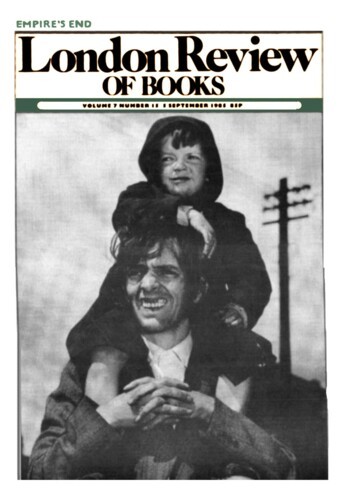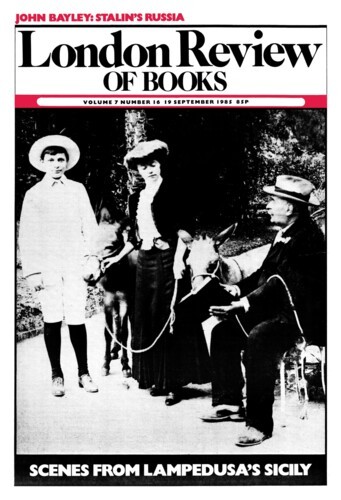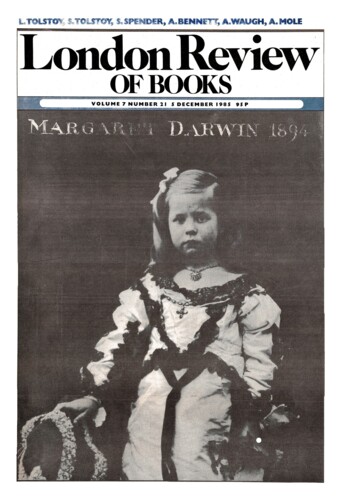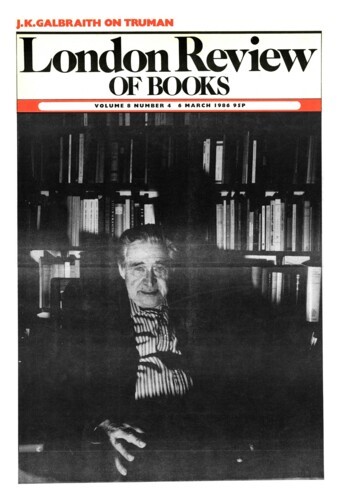Patricia Craig
Patricia Craig whose books include The Lady Investigates: Women Detectives and Spies in Fiction, written with Mary Cadogan, is working on a study of Northern Irish poetry and fiction.
Larks
Patricia Craig, 19 September 1985
‘But for Bunter the result might have been serious,’ says a character in the Magnet ‘India’ series of 1926, giving credit to the fat schoolboy blunderer whose tomfoolery – quite by accident – has saved the day. It’s a custom of Bunter’s to run headlong into things, with preposterously beneficial results for all concerned. David Hughes, in his latest novel, takes this trait and turns it on its head: the outcome of Bunter’s intervention in certain notable episodes of the 20th century is very serious indeed. By this account, Bunter is personally responsible for the arrest of Crippen and the sinking of the Titanic, not to mention the Somme debacle and consequent prolonging of the First World War. The throne of England is rocked because of Bunter. A fiery act of Bunter’s sparks off the General Strike. It’s Bunter’s tailor who runs up some subsequently notorious black shirts for Oswald Mosley and his followers. Churchill assumes power in 1940 at the behest of Bunter. Bunter is at the bottom of the Suez business. ‘The Waste Land’ is a patch of ground at the back of the Bunter residence. David Hughes even devises a comic genesis, involving Bunter, for Lady Chatterley’s Lover.’
Angela and the Beast
Patricia Craig, 5 December 1985
Angela Carter’s Black Venus is Baudelaire’s Creole mistress Jeanne Duval, whose hair the poet once likened to a sea of ebony, among other things; his enchantment and her disenchantment figure in the story, the first in an inspiriting new collection of eight by an inveterate scrutiniser of the whole romantic box of tricks. There’s Baudelaire’s voluptuous reverie, on the one hand – full of his chère indolente, le charme des soirs, with the astonishing hair – and, on the other, cross Jeanne, toughened by experience, poking with a stick at a smoky fire. Men and their fancies don’t count for much with this unimpressionable ex-cabaret dancer – un serpent qui danse, the poet said, using an image not highly regarded by the girl who knows perfectly well how snakes move. Nor is she willing to accept without comment the exotic heritage he foists on her – la langoureuse Asie et la brûlante Afrique (all that) – knowing herself, in fact, to be completely déracinée. Hasn’t her family history been all but excised, with only a Creole grandmother, gabbling a broken dialect, to anchor her to a shady lineage? Carter – who’s created a bizarre déité or two of her own. notably Fevvers in Nights at the Circus – imagines the reality behind the narcotic lines, in which the poet goes overboard for the scents of tar and musk and coconut oil. Pungent odours indeed.’
Squelching
Patricia Craig, 6 March 1986
Rosemary Curb and Nancy Manahan (a well-named pair) have assembled the testimonies of a lot of naughty American nuns and ex-nuns who chafed under the restrictions of convent life. One restriction in particular galled them all: the embargo on sexual activity. Few nuns, it seems, are natural celibates. Fewer still are heterosexual. An attraction to girls and women propelled them in droves into convents all over America, and out again when they found their inclinations didn’t tally with the requirements of the Church. As in the schoolgirl stories of Angela Brazil – who innocently named one of her heroines Lesbia – many of the friendships described in Breaking silence ‘flamed to red heat’. Angela Brazil perhaps didn’t understand the implications of the ardour she evoked. Neither did another children’s author, Elsie Oxenham, take full cognisance of the impulse that carried her characters, cheery adolescents all, into one another’s bedrooms and beds. You aren’t, with the Oxenham stories, invited to attribute anything but cosiness to the set-piece cocoa-drinking session which typically takes place at midnight with a special friend. Nuns, too, gaily visit one another’s rooms ‘to chat and hug’, or crawl through the window of a dormitory in which some irresistible confrère is sleeping. Indeed, the world of postulants and novitiates is very like the world of school and bosom friendships c. 1930, with young nuns arranging assignations in the convent broom cupboard or tub room. Delectable silliness and excitements are there in plenty. But the knowing modern nuns of Breaking silence are fully aware of what they’re up to – and once their passions are aroused, there is really no holding them: ‘Grope and fumble just would not do.’’
Hiberbole
Patricia Craig, 17 April 1986
The first work of collaboration between Edith Oenone Somerville and her cousin Violet Martin (‘Martin Ross’) was a Buddh dictionary – ‘Buddh’ being the family word for members of the family, and the dictionary consisting of words peculiar to it. ‘Blaut’, for instance, in Buddh circles, meant ‘violently to express immoderate fury’. The insufficiency of ordinary English, when it came to strong feelings, caused a good deal of improvisation among the Somervilles and their family connections. A feeling for the comically expressive phrase, we learn from Gifford Lewis’s affectionate study, asserted itself early on in the literary cousins. They couldn’t have been better placed to gratify it, what with family loquacity, and with Irish servants and tradespeople expostulating idiomatically all around them. ‘Sure the hair’s droppin’ out o’ me head, and the skin rollin’ off the soles o’ me feet with the heart scald I get with her!’: that sort of thing. Readers of the R.M. stories gain a strong impression of lower-class Irish hyperbole. Edith Somerville carried around with her a notebook in which she jotted down any local extravagance of speech she overheard. (She also carried a sketchbook in which she drew, very efficiently, Irish huntsmen: the inelegant in pursuit of the inedible.)’
Read anywhere with the London Review of Books app, available now from the App Store for Apple devices, Google Play for Android devices and Amazon for your Kindle Fire.
Sign up to our newsletter
For highlights from the latest issue, our archive and the blog, as well as news, events and exclusive promotions.





